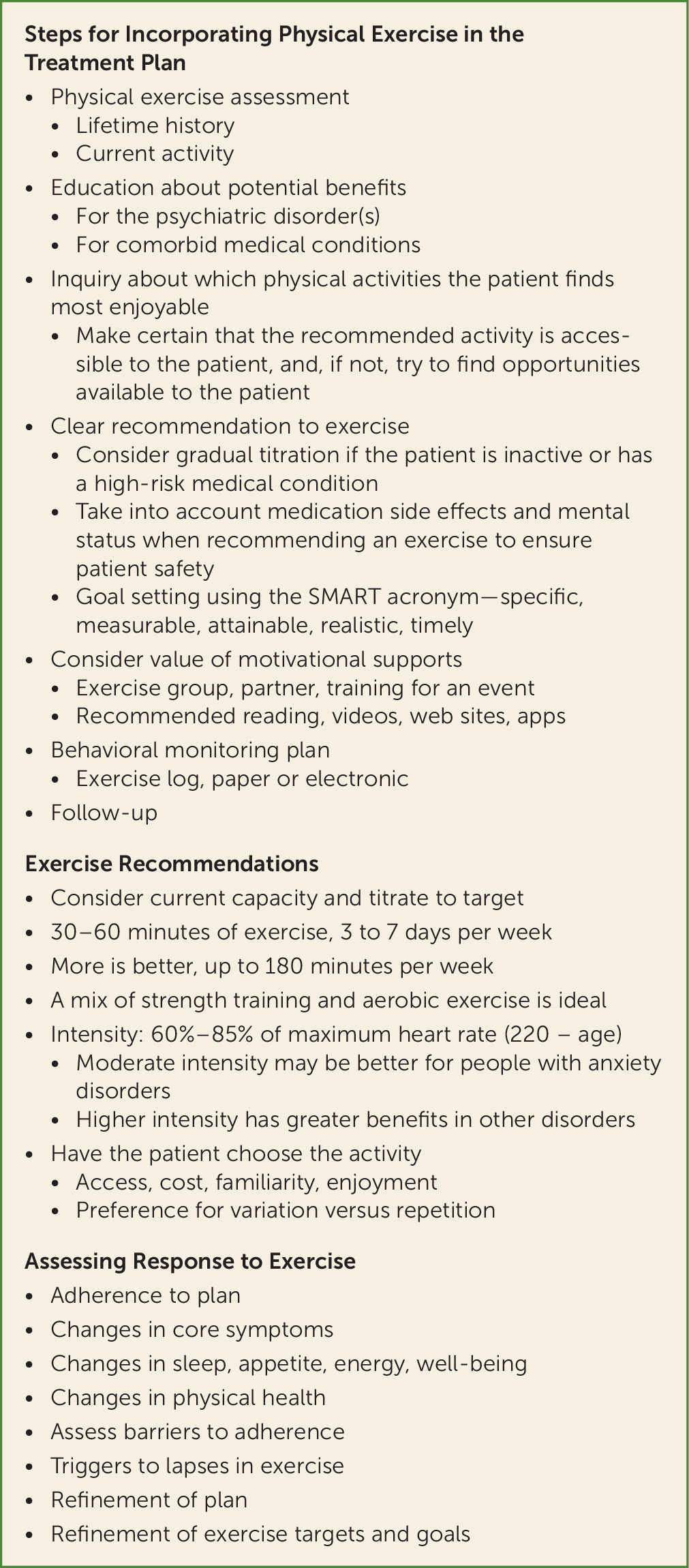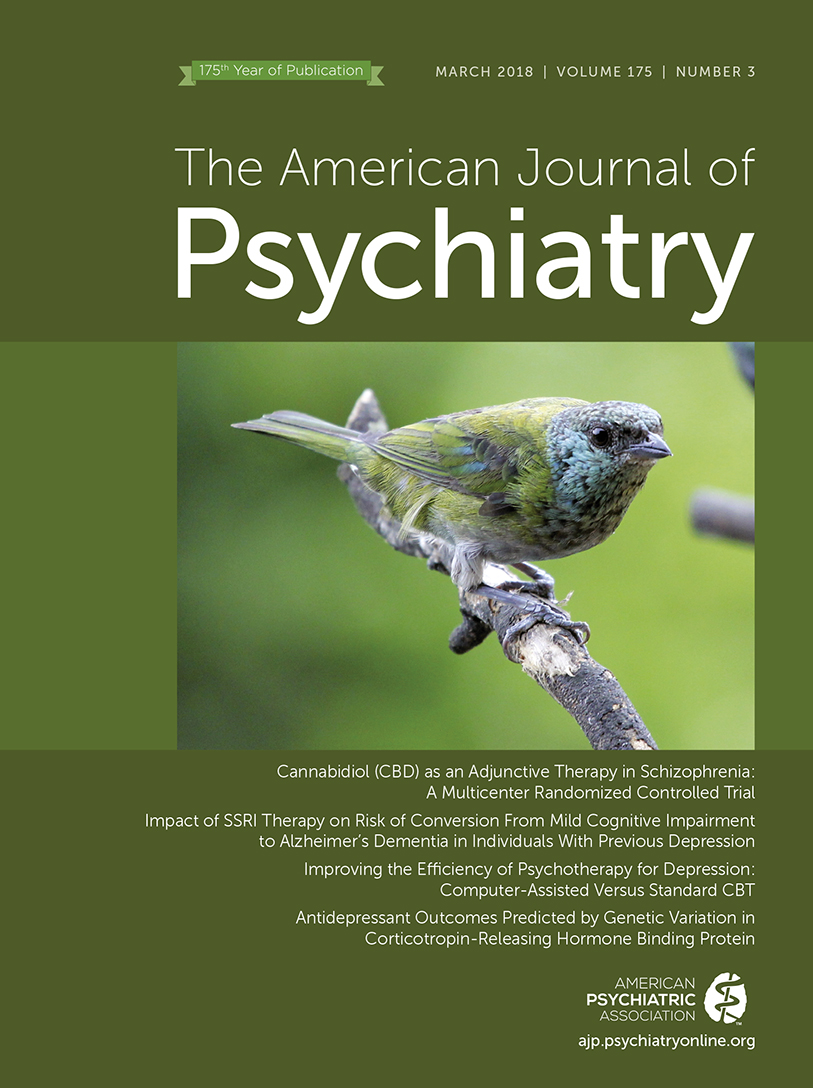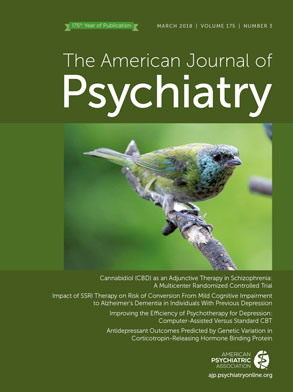Which of the following represents a potential mechanism by which exercise may have neuroprotective effects?
A.
Reduced neuroinflammation.
B.
Upregulation of neurotrophic growth factors.
C.
Potentiation of remyelination.
“Miguel” was 16 years old when he was referred to our clinic after social anxiety and depression evolved into signs of early psychosis. He had been in care for 2 years in private practice and was treated with various antidepressant medications and psychotherapy. During this time, he developed the perception that people strongly disliked him once they got to know him. He also heard his name called loudly from behind several times at school when no one was there. His community psychiatrist added risperidone, which suppressed the voices but led to lethargy and weight gain. A trial of aripiprazole was not effective, so he returned to taking risperidone along with escitalopram, gabapentin, and lorazepam. He was referred to our early psychosis program because of worsening symptoms and suicidal ideation despite this treatment.
On initial evaluation by our team, Miguel described extreme sadness and self-hatred associated with suicidal ideation. He was preoccupied with disliking his appearance, discomfort in social interactions, and feeling “stupid” in class relative to his peers despite receiving good grades. He feared impulsively acting on suicidal ideation. He reported that his friends at school could see and hear his thoughts when he was at home. He was sure that comments friends made at school confirmed that they knew his private thoughts. He also reported being watched in his room by schoolmates who wanted to catch him doing something embarrassing, and he had to position himself away from the window to avoid being monitored. He described intrusive fears of close family members being harmed or killed. He had a family history of schizophrenia in a second-degree and a third-degree relative. Miguel met the threshold for “severe and psychotic” on the Structured Interview for Psychosis-Risk Syndromes on two items (unusual thought content and suspiciousness/persecutory ideas) for less than 6 months, occurring at a frequency consistent with a psychotic episode. He was therefore given a diagnosis of schizophreniform disorder.
Miguel had been physically active in team sports throughout his school years. He had never experienced a concussion, and there was no head injury proximal to the onset of his symptoms. He had been inactive for months at the time of the initial interview because of lethargy and amotivation. The initial treatment plan included medication management, cognitive-behavioral therapy for psychosis, and lifestyle interventions, including regular physical exercise, a diet rich in fruits and vegetables, and supplementation with fish oil. Given the high level of acuity and risk, he was seen frequently by team members, with monitoring of lifestyle changes at every psychiatric visit. At the second visit, he reported feeling a sense of relief during a sports lesson, although his distress returned soon after the lesson ended. At that visit, his mother made a commitment to go walking with him daily. By the next session, he reported walking 1 hour daily, which he enjoyed and which led to improved mood and relaxation afterward. He continued daily exercise, including moderate-intensity weight training with a trainer at a gym for 30–60 minutes in addition to walking, with continued improvement in symptoms while engaged in physical activity. Both the patient and his family agreed that he felt his best during exercise, and his family committed to support him in regular participation.
Replacement of risperidone with lurasidone led to reduced side effects but no immediate improvement in psychotic symptoms, and a change to sertraline augmented with bupropion, buspirone, and trazodone was minimally helpful for his mood. Miguel remained intensely dysphoric and suicidal and felt hopeless about ever getting better, but he continued to report periods of respite after physical exercise. Over the next 6 months, the experience of thought broadcasting, monitoring, and family endangerment faded, but he described a disturbing buzzing feeling in his head and said he felt like part of his brain was missing. This evolved into a feeling of disconnection and perceptual distance from his environment and those around him.
He continued daily exercise with family support, and his periods of better mood began to lengthen. He also engaged in an alternative school setting with extensive individual support. While depersonalization persisted and was quite bothersome, all other psychotic symptoms resolved and suicidal ideation faded. Miguel expressed the concern that the medications were causing the buzzing feeling and interfering with his concentration. We therefore began a gradual process of tapering medications. By his eighth month in treatment, his regimen was simplified to sertraline, lurasidone, fish oil, and N-acetylcysteine, which was associated with some improvements in energy and concentration. After careful consideration of the risks and consequences of relapse, we proceeded to a careful taper of lurasidone at Miguel’s request to assess its impact on his feeling of impaired brain function. By the ninth month, lurasidone was discontinued, with some further improvement in energy and concentration, no change in the severity of depersonalization, and no return of psychotic symptoms or suicidal ideation.
Around this time, Miguel increased the intensity of his exercise regimen, with family support, including hour-long high-intensity swimming sessions 4 days per week with his father, interspersed with moderate-intensity weight training for 30–60 minutes and moderate-intensity hiking for 30–90 minutes with his mother or siblings on the remaining days. Miguel reported improved cognition in response to exercise, and he was able to return to a mainstream school setting. He strategically timed his physical exercise to occur between school and homework to achieve benefit for academic performance. Miguel’s family noticed gains, including a peaceful composure, a sense of relief, and genuine happiness. Close monitoring of symptoms during both psychiatric and psychotherapy visits revealed no evidence of a return of psychosis, and the experience of disconnection became somewhat more tolerable. He noted that focus on the technical aspects of a sport and being in nature during hikes were helpful in enabling him to feel more connected to his surroundings. By the 14th month, he successfully completed a term in school, remained in remission from psychosis and suicidal ideation, reported varying levels of anxiety in response to life stressors, and was making plans to continue his education.


